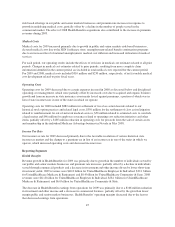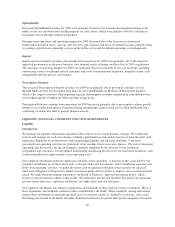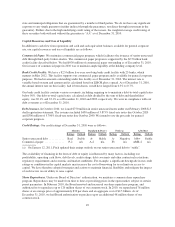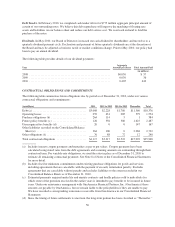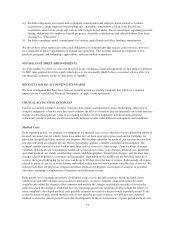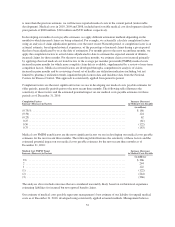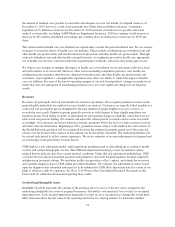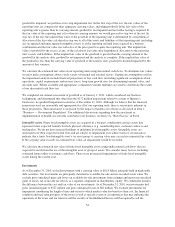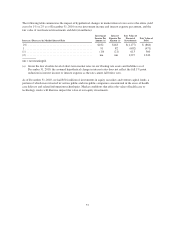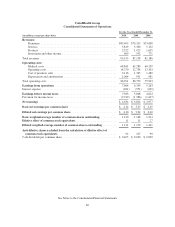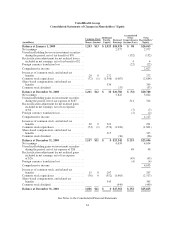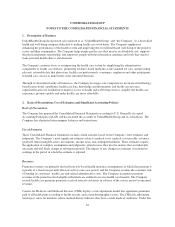United Healthcare 2010 Annual Report Download - page 56
Download and view the complete annual report
Please find page 56 of the 2010 United Healthcare annual report below. You can navigate through the pages in the report by either clicking on the pages listed below, or by using the keyword search tool below to find specific information within the annual report.goodwill is impaired, we perform a two-step impairment test. In the first step of the test, the fair values of the
reporting units are compared to their aggregate carrying values, including goodwill. If the fair value of the
reporting unit is greater than its carrying amount, goodwill is not impaired and no further testing is required. If
the fair value of the reporting unit is less than its carrying amount, we would proceed to step two of the test. In
step two of the test, the implied fair value of the goodwill of the reporting unit is determined by a hypothetical
allocation of the fair value calculated in step one to all of the assets and liabilities of that reporting unit (including
any recognized and unrecognized intangible assets) as if the reporting unit had been acquired in a business
combination and the fair value was reflective of the price paid to acquire the reporting unit. The implied fair
value of goodwill is the excess, if any, of the calculated fair value after hypothetical allocation to the reporting
unit’s assets and liabilities. If the implied fair value of the goodwill is greater than the carrying amount of the
goodwill at the analysis date, goodwill is not impaired and the analysis is complete. If the implied fair value of
the goodwill is less than the carrying value of goodwill at the analysis date, goodwill is deemed impaired by the
amount of that variance.
We calculate the estimated fair value of our reporting units using discounted cash flows. To determine fair values
we must make assumptions about a wide variety of internal and external factors. Significant assumptions used in
the impairment analysis include financial projections of free cash flow (including significant assumptions about
operations, capital requirements and income taxes), long-term growth rates for determining terminal value, and
discount rates. Where available and appropriate, comparative market multiples are used to corroborate the results
of our discounted cash flow test.
We completed our annual assessment of goodwill as of January 1, 2011, which considered our business
realignment, and determined that other than the $172 million impairment related to certain of Ingenix’s
businesses, no goodwill impairment existed as of December 31, 2010. Although we believe that the financial
projections used are reasonable and appropriate for all of our reporting units, there is uncertainty inherent in
those projections. That uncertainty is increased by the impact of health care reforms as discussed in Item 1,
“Business — Government Regulation”. For additional discussions regarding how the enactment or
implementation of health care reforms could affect our business, see Item 1A, “Risk Factors” in Part I.
Intangible assets. Finite lived intangible assets are acquired in a business combination and are assets that
represent future expected benefits but lack physical substance (e.g., membership lists, customer contracts and
trademarks). We do not have material holdings of indefinite lived intangible assets. Intangible assets are
amortized over their expected useful lives and are subject to impairment tests when events or circumstances
indicate that a finite lived intangible asset’s (or asset group’s) carrying value may exceed its estimated fair value.
If the carrying value exceeds its estimated fair value, an impairment would be recorded.
We calculate the estimated fair value of finite lived intangible assets using undiscounted cash flows that are
expected to result from the use of the intangible asset or group of assets. We consider many factors, including
estimated future utility to estimate cash flows. There were no material impairments of finite lived intangible
assets during the current year.
Investments
As of December 31, 2010, we had investments with a carrying value of $16.8 billion, primarily held in marketable
debt securities. Our investments are principally classified as available-for-sale and are recorded at fair value. We
exclude gross unrealized gains and losses on available-for-sale investments from earnings and report net unrealized
gains or losses, net of income tax effects, as a separate component in shareholders’ equity. We continually monitor
the difference between the cost and fair value of our investments. As of December 31, 2010, our investments had
gross unrealized gains of $527 million and gross unrealized losses of $81 million. We evaluate investments for
impairment considering the length of time and extent to which market value has been less than cost, the financial
condition and near-term prospects of the issuer as well as specific events or circumstances that may influence the
operations of the issuer and our intent to sell the security or the likelihood that we will be required to sell the
54



